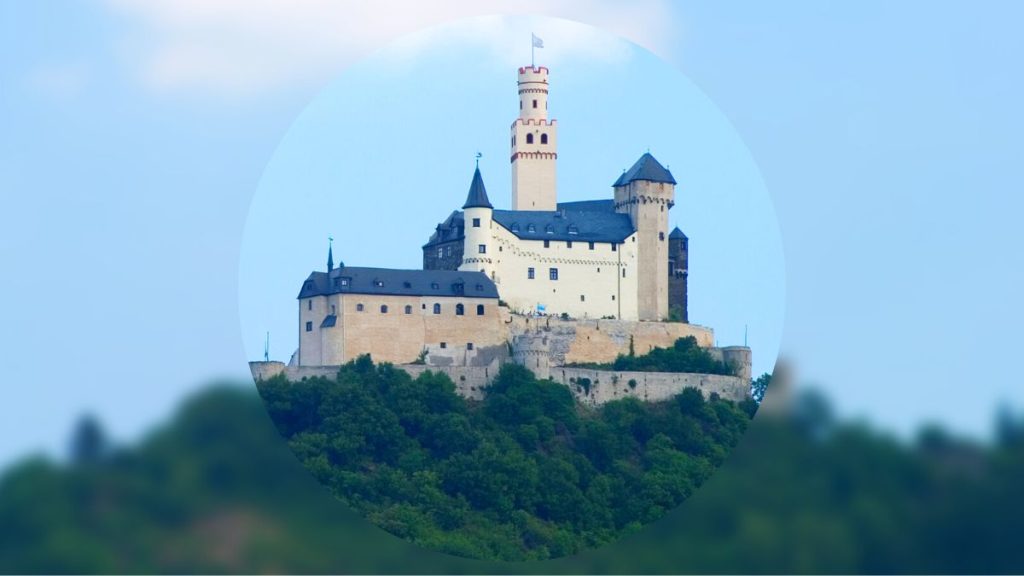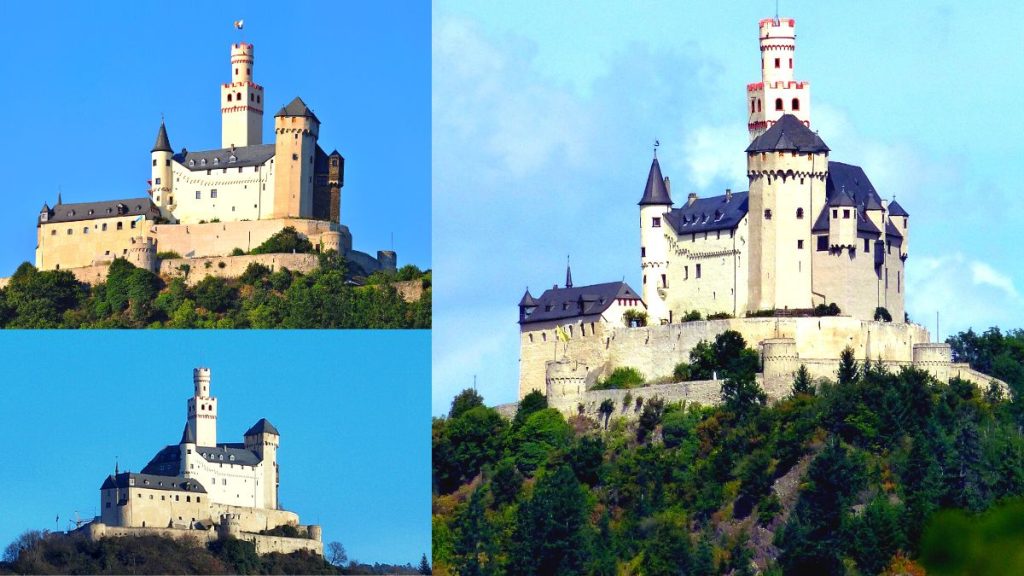The finest castle in the entire Middle Rhine Valley is ready for visitors at Braubach, a little-known village close to Koblenz, Germany. Among the top castles to see in Germany is Marksburg Castle, which was built in 1117. This explains why a tour of Marksburg Castle is given on numerous Rhine river cruises. Don’t be tricked by the word “castle” in the name. Since it’s not planned to be a castle for royalty, this Marksburg structure has nothing in connection with fairy tales. Marksburg castle was built with defense in mind, like other country castles. In this article, you will find everything you need to know about the Marksburg Castle tour.
Is Marksburg Castle Worth Touring?
The majestic castles that flank the Rhine are mainly Romantic Era reconstructions. Most of its construction is original. Contrarily, Marksburg has withstood raids, Napoleonic rule, and two World Wars.
While Marksburg Castle’s original hold is still the core of the complex, it has evolved over the years. It has been occupied for more than 700 years and is the only castle on the Rhine River that hasn’t been destroyed. As you move through the structure, it is evident that most of the modifications were made for security.
Marksburg Castle Tour Review

On our Marksburg castle tour, we visited Marksburg Castle. Everybody was warmly bused to the hilltop by the company. There’s no shuttle service offered from the castle, and it’s a lengthy and steep walk. At the castle gate, we joined our tour guide. She took the lead as she led us to the gate.
- Drawbridge Gate – Four gates must be passed to access the Marksburg. The first is a huge drawbridge gate, accompanied by a vaulted tunnel with an old bookshop on the right that was once the castle’s gatekeeper’s room.
- Fox Gate – At the Fox Gate, the second medieval entranceway, the guided tour of the castle begins. Don’t miss getting your ticket at the gift shop’s ticket window.
- Arrow Slit Gate – The Arrow Slit Gate’s third gate has a machicolation, a tiny oriel from which the guards could hurl stones at invading foes if they’d gone that far. Toward the end of the seventeenth century, the Steward’s Tower gateway’s size decreased.
- Riders’ Stairway – We have arrived at a wall display that shows the coats of the armor of each ruler of Marksburg Castle in order, from the Counts of Eppstein to the Deutsche Burgenvereinigung (German Castles Association). The “Riders Stairway,” a centuries-old bedrock carving, is where we start our tour of the castle.
- Romanesque Palas – The Romanesque Palas is the earliest major building. Since its beginnings in 1239, it has undergone various modifications. The Deutsche Burgenvereinigung’s general manager’s office and apartment are now placed there (German Castles Association). The Palas is a section of the castle’s non-tourable regions. After the Middle Ages, while guards lived in the castle for ages, those sections were changed from within.
- Small Battery – In the artillery battery located in front of Palas, which was built in 1711, is a duplicate of one of the oldest firearms of its kind in Germany, dating from 1450. The artillery yard of Marksburg Castle had the foundation walls of a chapel that was destroyed in 1588. The walls were hard to date correctly and could be more ancient than the castle.
- Great Battery – These “Great Battery” cannons are pointed at the Rhine. We differ between 6-pound and 12-pound front-loading cannons based on weight. The soldiers could protect the Rhine valley’s whole width with a range of roughly 1000 meters. This military structure’s earlier portion was built in 1589, and its later section was in 1711.
- Garden – We proceed into the Upper Bailey, where two patches of roughly 150 plants were common in Europe during the Middle Ages. Most of them are highly medicinal plants and spices, although some as mandrake and Devil’s snare—were supposedly used by witches, others as deadly nightshade and hemlock—which are extremely toxic.
- Wine Cellar – The castle’s great central tower is placed in the courtyard that is accessible by climbing a wooden staircase. We will now tour the wine cellar, which has a 17th-century interior.
- Castle Kitchen – The Gothic Hall Building, built in 1435, has a kitchen on its first floor. The noble family typically ate in their hall upstairs, keeping the kitchen entirely for the servants.
- Bed Chamber – The noble family’s bed chamber is the initial area on the upper level. It is adorned with wood paneling, a canopied four-poster bed, a cradle, and a seating and reading space in the window niche. It was one of few rooms in the castle with a stove for heating.
- Great Hall – The majestic Great Hall the focus of courtly life. A tiny hole in the exterior wall accesses the medieval privy. In the mixed living and eating hall, free time was used playing chess or composing music while enjoying the rare entertainment of traveling singers who also shared stories and news.
- Chapel – We then go into the chapel, which dates to the 14th century and forms a section of the chapel tower. At first sight, the chapel seems tiny, but we must realize that the noble family would only utilize it for regular prayers and services. A figure of the Rhenish Virgin Mary from the 15th century can be seen in the niches.
- Rhine Wing – The Rhine Wing, the most current structure built in 1706, is accessed via a small stairway carved into the wall that passes the castle chaplain’s seat.
- Armoury – Our next visit is among the tour’s highlights: the “Gimbel Collection,” a gathering of 12 life-size figures from 1880 that depicts the growth of weapons and armor from old to modern times. Both original items and highly accurate copies of armor are on display. Coins, glass, arrowheads, dice, and other items from excavation work done in and around castle grounds are shown in a glass cabinet.
- Keep – The small keep that acts as a status thing and watchtower instead of a residential structure meets us at the center of the courtyard. Founded in 1239, the lower section, and expanded in 1468, is the top section. There’s no emergency exit at all, and people cannot pass one another on the stairs due to the tiny, steep, uneven stairwell in the center of the tower.
- Former Stables – A temporary exhibition on torture and punishment in the Middle Ages and early Modern eras is on show in the oldest part of the castle, the Romanesque Palas basement, which once held the horse stables.
- Blacksmith’s Workshop – We can get a great idea of what a late medieval forge would seem like from the small space carved out of the rock.

Summary
The Eppstein family built Marksburg Castle in 1100, one of only two to stay intact. This is certainly a castle you shouldn’t miss if you’re considering a trip to the region and aren’t sure which to pick. The booklet only covers a few highlights, and you’ll miss some really interesting details; therefore, if you wish to see and understand the majority of you’re the Marksburg castle tour, you should take an English-speaking guided tour.
FAQ
When does Marksburg Castle open?
Apart from Christmas Eve and Christmas Day, Marksburg Castle is accessible all year. Late March to October: 10:00–17:00. It is accessible from 11:00 to 16:00 from November through late March.
How can I get to Marksburg Castle?
Parking is available in the park at the top of the hill if you drive. Otherwise, you’ll have to walk or hire a taxi. But getting to the castle on foot is a difficult 30-minute walk.
Do they allow solo tours to Marksburg Castle?
Self-guided tours are not possible at this location. Only a 50-minute guided tour is offered for visiting this castle.
| Related Article |
| Facts about Duntrune Castle in Scotland |

